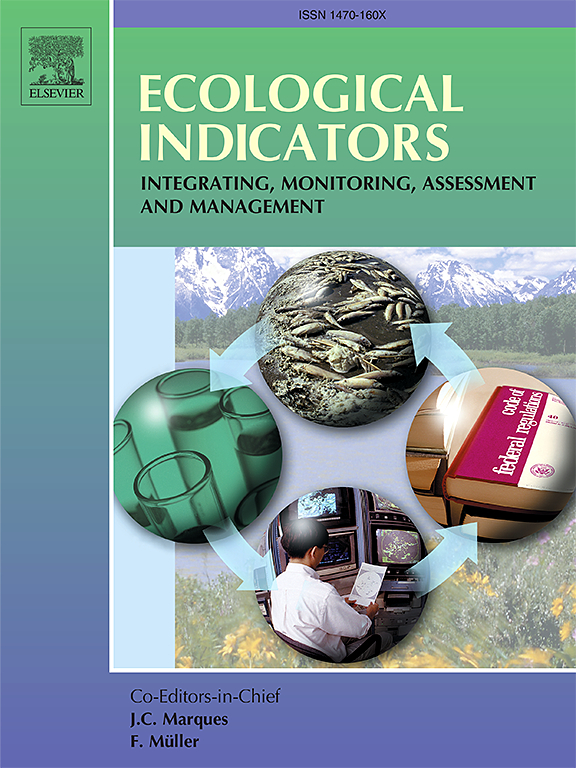未来全球干旱敏感地区将会扩大
IF 7
2区 环境科学与生态学
Q1 ENVIRONMENTAL SCIENCES
引用次数: 0
摘要
气候变化和人类活动正在加剧干旱条件,显著改变干旱的传播过程。然而,这些变化仍然没有得到充分的了解,特别是对于典型的干旱分区,如潮湿、干旱敏感和干旱类型的干旱传播分区。因此,本研究在三个共享的社会经济路径(SSP1-2.6、SSP3-7.0和SSP5-8.5)下考察了这些分区的变化,以阐明全球干旱趋势。结果表明,全球干旱敏感区将扩大1.89 × 106 km2,大致相当于苏丹的面积(1.88 × 106 km2)。值得注意的是,仅在南美洲,预计干旱敏感地区将增加1.27 × 106平方公里,相当于尼日尔的面积。而在南美洲,湿润分区将缩小1.45 × 106平方公里,其中近60%过渡到干旱敏感区。总体而言,在SSP5-8.5情景下,预计人类活动将使干旱分区朝着不利的方向发展,大约3.26 × 106 km2将从湿润型分区转向干旱敏感区或从干旱敏感区转向干旱型分区,与印度的面积(3.29 × 106 km2)相似。在所有气候带中,以湿润半干旱区变化最为显著。在美国大平原、南欧和中欧以及南美洲的亚马逊盆地,干旱传播模式明显发生重大变化,降水减少和陆地-大气耦合加剧是主要驱动因素。这些发现为气候变化背景下的干旱预测和管理提供了重要的见解。本文章由计算机程序翻译,如有差异,请以英文原文为准。

The global drought-sensitive areas will expand in the future
Climate change and human activities are intensifying drought conditions, significantly altering drought propagation processes. However, these changes remain insufficiently understood, particularly for typical drought partitions such as humid, drought-sensitive, and arid types of drought propagation partition. Therefore, this study examines the change on these partitions under three Shared Socioeconomic Pathways (SSP1-2.6, SSP3-7.0, and SSP5-8.5) to elucidate global drought trends. The results show that the global drought-sensitive area will expand by 1.89 × 106 km2, which is roughly the size of Sudan (1.88 × 106 km2). Notably, in South America alone, the drought-sensitive area is projected to increase by 1.27 × 106 km2, equivalent to the size of Niger. While in South America the humid partition will shrink by 1.45 × 106 km2, with nearly 60 % transitioning into drought-sensitive areas. Overall, human activities are expected to drive drought partitions in an unfavorable direction, with approximately 3.26 × 106 km2 will shift from humid-type partition to drought-sensitive areas or from drought-sensitive areas to arid-type partitions under the SSP5-8.5 scenario, similar to the size of India (3.29 × 106 km2). Among all the climate zones, the changes are most notable in the humid and semi-arid regions. Significant transformations in drought propagation patterns are evident in the Great Plains of the United States of America, southern and central Europe, and the Amazon basin in South America, where declining precipitation and intensifying land–atmosphere coupling are the main driving factors. These findings provide critical insights for drought prediction and management in the context of climate change.
求助全文
通过发布文献求助,成功后即可免费获取论文全文。
去求助
来源期刊

Ecological Indicators
环境科学-环境科学
CiteScore
11.80
自引率
8.70%
发文量
1163
审稿时长
78 days
期刊介绍:
The ultimate aim of Ecological Indicators is to integrate the monitoring and assessment of ecological and environmental indicators with management practices. The journal provides a forum for the discussion of the applied scientific development and review of traditional indicator approaches as well as for theoretical, modelling and quantitative applications such as index development. Research into the following areas will be published.
• All aspects of ecological and environmental indicators and indices.
• New indicators, and new approaches and methods for indicator development, testing and use.
• Development and modelling of indices, e.g. application of indicator suites across multiple scales and resources.
• Analysis and research of resource, system- and scale-specific indicators.
• Methods for integration of social and other valuation metrics for the production of scientifically rigorous and politically-relevant assessments using indicator-based monitoring and assessment programs.
• How research indicators can be transformed into direct application for management purposes.
• Broader assessment objectives and methods, e.g. biodiversity, biological integrity, and sustainability, through the use of indicators.
• Resource-specific indicators such as landscape, agroecosystems, forests, wetlands, etc.
 求助内容:
求助内容: 应助结果提醒方式:
应助结果提醒方式:


